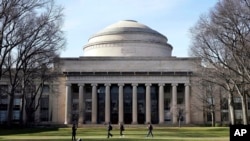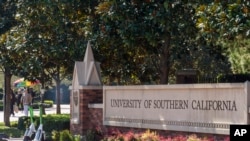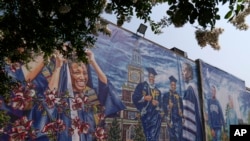Student Union
Rankings Compare College Costs to Future Income

Most students and their families quickly dive into rankings when searching for the “best colleges and universities.”
However, Georgetown University, itself on many of those “best college” lists, has veered from rankings based on grade-point averages, admission rates and SAT scores, and come up with a new metric, ranking institutions of higher education based on the financial return students receive from their investment in the school.
Traditional private, four-year schools that offer bachelor’s degrees have the highest returns on investment not just immediately after graduation, but 40 years after enrollment, Georgetown’s report on the ranking says.
“For example, Babson College, a private college in Massachusetts, ranks 304th in net present value at the 10-year horizon, but ranks seventh at the 40-year horizon,” Georgetown’s University Center on Education and the Workforce said. Its detailed project included 4,500 schools that offer degrees and certificates.
Tops on the list for return on investment over 40 years was Albany College of Pharmacy and Health Sciences, a private nonprofit institution that costs about $50,000 per year. It was calculated to return $385,000 at 10 years, $1.3 million at 20 years, and $2.72 million on that investment to the graduate after 40 years.
By comparison, the private, nonprofit, four-year Stanford University in California that ranked No. 5 on the Georgetown list would return $307,000 in 10 years, $1.013 million in 20 years; and $2.068 million in 40. Tuition and fees are about the same as Albany College of Pharmacy.
Those calculations are published prices and do not include financial aid discounts.
“Everyone is asking, ‘Is college worth it?’ and we set out to try to find an answer,” said Anthony P. Carnevale, lead author and CEW director in a statement. “Not only will it help students, but this kind of information on the costs and benefits of higher education holds institutions more accountable.”
Carnevale served for a decade as vice president for public leadership at the Educational Testing Service, the largest private nonprofit testing service, which administers the SAT and other tests that are required or highly recommended for admission into higher-education programs.
Data from some obvious affordable schools CEW could not gain access to include the U.S. service academies. Those schools do not collect tuition and fees, and students are given stipends to pay for expenses like dry cleaning, barbers and laundry. Admission and graduation is exchanged for service in the U.S. military after graduation.
And who’s who in Georgetown’s Top 20? Some names you don’t typically see in the popular annual rankings and careers that you won’t find on many other lists. (Hint: Get your sea legs on.)
Albany College of Pharmacy and Health Sciences (N.Y.)
St. Louis College of Pharmacy (Mo.)
Massachusetts College of Pharmacy and Health Sciences (Mass.)
Massachusetts Institute of Technology (Mass.)
Stanford University (Calif.)
Maine Maritime Academy (Maine)
Babson College (Mass.)
Harvard University (Mass.)
Georgetown University (D.C.)
U.S. Merchant Marine Academy (N.Y.)
University of the Sciences (Pa.)
St Paul’s School of Nursing-Queens (N.Y.)
Massachusetts Maritime Academy (Mass.)
Harvey Mudd College (Calif.)
Stevens Institute of Technology (N.J.)
University of Pennsylvania (Pa.)
California State University Maritime Academy (Calif.)
California Institute of Technology (Calif.)
Colorado School of Mines (Colo.)
Bentley University (Mass.)
No, that’s not a typo, you are reading correctly: Pharmacy and maritime schools offer excellent return on investment along with notable STEM colleges and universities.
For-profit and certificate schools scored the lowest return on investment, and include beauty, rabbinical, ethnic and arts schools.
See all News Updates of the Day
US remains top choice for Indian students going abroad

About 69% of Indian students traveling abroad for their studies chose the United States, according to a Oxford International’s Student Global Mobility Index. Other popular choices were the United Kingdom, Canada and Australia.
Education Times reports the main influencers for deciding where to study abroad – for Indian students and others – were parents. (April 2024)
Malaysian official: Schools can’t turn away from global tensions

Zambry Abdul Kadir, Malaysia’s higher education minister, said protests spreading across universities in the United States show that schools can’t ignore political tensions.
Helen Packer, reporting in Times Higher Education, said the minister reminded educators that universities are key in the development of leaders, individuals and societies. (April 2024)
Social media breaks are difficult, but necessary

Between online classes, maintaining social connections and working on projects, college students can have a hard time disengaging from the demands of technology.
In Florida International University’s PantherNOW, Ariana Rodriguez offers strategies for taking a break from social media. (April 2024)
- By Melos Ambaye
Many master's degrees aren't worth the investment, research shows

Nearly half of master's degrees have a negative financial return, according to new research by the Foundation for Research on Equal Opportunity, an economic research organization.
The study indicates that many graduate degree programs do not increase lifetime earnings enough to be worth it.
While 23% of bachelor’s degree programs yield a negative financial return on investment, 43% of two-year degrees and master’s degrees fail to deliver a return, according to the study by Preston Cooper, a senior fellow at FREOPP.
Cooper assessed the return on investment for 53,000 degree and certificate programs to determine whether a student’s lifetime earnings outweigh program costs and the risk of not completing their degree.
His findings show that a student’s field of study was the overriding indicator of return on investment at the undergraduate and graduate level.
Engineering, computer science and nursing bachelor’s degrees have high financial returns on investment, while programs in education, fine arts, psychology and English usually have low returns.
Graduate degrees in medicine and law tend to have strong payoffs. But a large share of master’s programs, including the MBA, frequently have low payoffs, according to Cooper.
Although workers with master’s degrees earn 16% more than those with only bachelor’s degrees, Cooper says the figure fails to account for students who had “higher preexisting earnings potential.”
“MBA students typically have high preexisting earnings potential, having often chosen high-ROI undergraduate majors such as finance and economics,” Cooper writes. “So the MBA adds little value on top of that.”
The study indicates that high starting salaries are predictors of high returns on investment. Degrees with starting salaries of $57,000 a year or more deliver the best lifetime returns.
But the return on investment of a degree can vary depending on the educational institution.
“Students interested in fields with low average pay can still find some schools that do well transforming those fields of study into high-paying careers,” Cooper writes.
The quality of an institution also matters, said William Tierney, professor emeritus of higher education at the University of Southern California.
“An MBA from Harvard is a likely ticket to a good job,” Tierney told VOA. “An MBA from the University of Phoenix, less so.”
But students pursue graduate programs for more than just financial reasons.
“Some degrees open up careers in fields that students may enjoy, such as in the performing arts,” Robert Kelchen, head of educational leadership at the University of Tennessee, Knoxville, told VOA.
“Others can help gain access to social networks or simply help students learn about a topic that is of interest,” Kelchen added.
Cooper told VOA that it might make sense for students in degree programs with low returns on investment to switch majors if they can still graduate on time.
He found the worst outcome for a student’s return on investment is dropping out of college “because they must pay for one or more years’ tuition and spend time out of the labor force.”
Lawmakers who fund higher education have a responsibility in ensuring “higher education delivers on its promise of economic mobility,” Cooper said.
Nearly a third of federal funding, including Pell grants and student loans, pays for higher education programs that fail to provide students with a return on investment, according to the study.
Cooper’s view is that “some schools should shut down low-ROI programs and reallocate institutional resources to programs with a better return.”
“There's definitely this narrative out there that higher education is always worth it, and you should always try to get that extra degree because it will increase your earnings,” he told VOA. “That's reinforced by colleges who make lofty promises regarding their graduate degree programs' outcomes, which all too often fall short.”
Harvard students end protest as school agrees to discuss Gaza conflict

Protesters against the war between Israel and Hamas were voluntarily taking down their tents in Harvard Yard on Tuesday after university officials agreed to discuss their questions about the endowment, bringing a peaceful end to the kinds of demonstrations that were broken up by police on other campuses.
The student protest group Harvard Out of Occupied Palestine said in a statement that the encampment "outlasted its utility with respect to our demands." Meanwhile, Harvard University interim President Alan Garber agreed to pursue a meeting between protesters and university officials regarding the students' questions.
Students at many college campuses this spring set up similar encampments, calling for their schools to cut ties with Israel and businesses that support it.
The Israel-Hamas war began when Hamas and other militants stormed into southern Israel on October 7, killing some 1,200 people and taking 250 hostages. Palestinian militants still hold about 100 captives, and Israel's military has killed more than 35,000 people in Gaza, according to Gaza's Health Ministry, which doesn't distinguish between civilians and combatants.
Harvard said its president and the dean of the Faculty of Arts and Sciences, Hopi Hoekstra, will meet with the protesters to discuss the conflict in the Middle East.
The protesters said they worked out an agreement to meet with university officials, including the Harvard Management Company, which oversees the world's largest academic endowment, valued at about $50 billion.
The protesters' statement said the students will set an agenda that includes discussions on disclosure, divestment, reinvestment and the creation of a Center for Palestine Studies. The students also said that Harvard has offered to retract suspensions of more than 20 students and student workers and back down on disciplinary measures faced by 60 more.
"Since its establishment three weeks ago, the encampment has both broadened and deepened Palestine solidarity organizing on campus," a spokesperson for the protesters said. "It has moved the needle on disclosure and divestment at Harvard."










